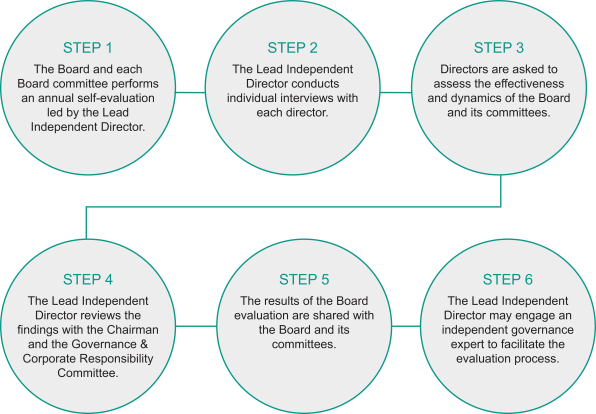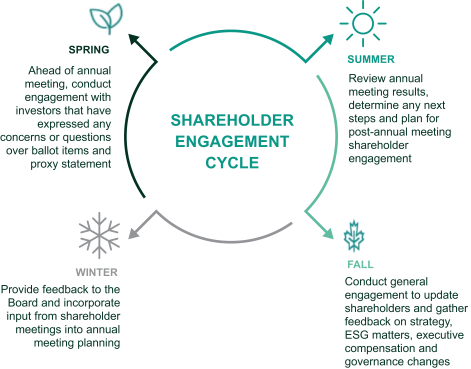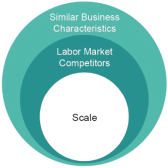Proxy Statement Summary
We have a solid strategy to guide us, which is focused on improving our core competitiveness and delivering higher productivity solutions today, while positioning for the future. In order to drive our strategy forward, we developed a three-pronged approach to guide our execution, which consists of transforming our core, investing for growth, and positioning for new frontiers in the energy space.
|
|
|
|
|
| TRANSFORM OUR CORE |
|
|
|
• Completed portfolio rationalization across multiple businesses across the globe • Restructuring from four product companies to two business segments, removing $150+ million in costs by the end of 2023 |
| |
|
|
|
|
| INVEST FOR GROWTH |
|
|
|
• Acquisitions of Quest Integrity, AccessESP, and BRUSH Power Generation • Opening of our new Chemicals manufacturing center in Singapore to better serve OFSE customers and support growth in the Eastern Hemisphere |
| |
|
|
|
|
| POSITION FOR NEW FRONTIERS |
|
|
|
• 2022 marked the largest volume booked to date in New Energy orders ($400+ million) • Established new partnerships and made new early-stage investments and acquisitions in 2022, including HIF Global, Mosaic Materials, NETPower, and GreenFire Energy |
Our responsibility
We organize our efforts into the areas of people, planet, and principles, and we work hard to make measurable progress each year. We strive to improve the transparency of our reporting and challenge ourselves to perform at the level of the most responsible companies in the world, not just in our own industry.
People
At Baker Hughes, our people are central contributors to our purpose of taking energy forward. As an energy technology company with operations around the world, we believe that a diverse workforce is critical to our success, and we aim to attract the best and most diverse talent to support the energy transition. We strive to be an inclusive and safe workplace, with opportunities for our employees to grow and develop in their careers, supported by learning and development opportunities, competitive compensation, benefits and health and wellness programs, and programs that build connections between our employees and their communities.
Diversity, Equity, and Inclusion (“DEI”): We believe unique ideas and perspectives fuel innovation and our differences make us stronger. We value difference in gender, race, ethnicity, age, gender identity, sexual orientation, ability, cultural background, religion, veteran status, experience, and thought across the globe. We celebrate the diversity and uniqueness of each employee and believe that everyone has the right to be treated with fairness, dignity, and respect. In addition, we continue to focus on the hiring, retention, and advancement of our global talent.
Our 2021 EEO-1 consolidated report can be found on our website at www.bakerhughes.com. Information contained on or connected to our website is not incorporated by reference into this Proxy Statement and should not be considered part of this Proxy Statement or any filing we make with the Securities and Exchange Commission (“SEC”).
Talent Acquisition: We have enacted a number of initiatives to support our global goal of increasing the number of diverse employees. We have conducted training on unconscious bias and launched pilot projects on blind resumes and debiasing job descriptions, interview templates, and assessments. As well, we have expanded our talent acquisition focus to include executive search services.
Inclusive Culture: We have several programs and initiatives that cultivate a culture and environment where everyone feels they belong and can thrive and contribute. Employees participate in Employee Resource Groups (“ERGs”), which elevate the conversation and awareness around DEI issues. All employees are welcome to join an ERG either as members of represented communities or as allies. Our DEI education framework provides goals aimed to provide our workforce with tools, resources, and learning opportunities focused on raising awareness, fostering inclusive behaviors, and building cultural competence. We also continue to assess and provide programs and policies that support our employees, including flexible work arrangements.
Charitable Work: Baker Hughes seeks to make a positive impact in the communities where we operate around the world through shareholder engagement, community service, and charitable contributions. Consistent with our purpose and values, we work to advance environmental quality, educational opportunities, and health and wellness. We benefit our communities through financial contributions, in-kind donations of goods and services, and volunteer projects. The Baker Hughes Foundation makes strategic philanthropic contributions, matches Baker Hughes employee charitable contributions, and awards volunteer recognition grants for outstanding employee community service. In order to align with the Company’s strategy to build the energy workforce of the future and promote a diverse, equitable, and inclusive workplace, the Baker Hughes Foundation announced $1 million in grants to four historically Black colleges and universities for the 2022-2023 academic year as part of its long-running mission to promote education and opportunity in the
|
|
|
|
|
|
|

|
|
3 |





















 Chair * Lead Director ** Audit Committee Financial Expert on Audit Committee
Chair * Lead Director ** Audit Committee Financial Expert on Audit Committee 








































